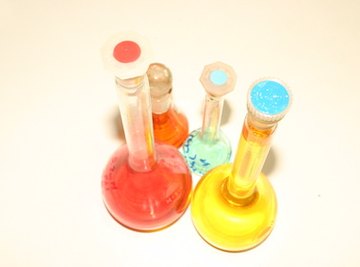
The air in Earth's atmosphere consists of nitrogen (78 percent), oxygen (21 percent), argon (0.93 percent), carbon dioxide (0.038 percent) and other trace gases, including water vapor and other noble gases. Scientists can extract trace gases from air by using filters or cooling the air. For example, carbon dioxide turns into a solid at −79 °C ( −110 °F). To separate a sample of air into its primary components – nitrogen and oxygen – they have to cool the air significantly more, down to −200 °C (−328 °F), which is almost as cold as the surface of Pluto. The process is known as the fractional distillation of liquid air or cryogenic distillation. It requires an air separation unit which is not unlike a conventional distillation tube used for purifying water.
How Separation of Gases by Fractional Distillation Works
Each gas has a characteristic boiling point, defined as the temperature at which it transforms from a liquid into a gas. If you have a random sample of gases, you can separate them by gradually cooling the sample until each component gas liquifies. The liquified compound falls to the bottom of a collection vessel. After all of the liquid has been retrieved, cooling continues until the temperature drops to the boiling point of the next compound and it liquifies. Some compounds, such as carbon dioxide, never liquify. Instead, they turn directly into solids, which are easier to retrieve than liquids.
The Fractional Distillation of Liquid Air
An air separation unit is often called an oxygen or nitrogen generator, since its purpose is to extract one or both of these elements from the air. In the distillation process, the air is first passed through a filter that absorbs all the water vapor. Then the cooling process begins. It involves the use of turbines and high-energy refrigeration systems. Carbon dioxide and other trace gases settle out when the temperature reaches each of their sublimation or boiling points. Sublimation describes the change of state directly from a solid to a gas.
When the temperature reaches −200 °C, the liquified mixture is fed through a tube into a vessel that is slightly warmer at the bottom (−185 °C) than it is at the top ( −190 °C). Oxygen liquifies at −183 °C, so it flows out of the flask through a tube in the bottom. Nitrogen turns back into a gas, however, because its boiling point is −196 °C. It flows out through a tube connected to the top of the flask.
Other Types of Air Separation Units
Separation of gases by fractional distillation isn't the only way to generate oxygen or nitrogen from air. A membrane generator uses a system of semipermeable, hollow-fiber membranes that allow smaller molecules in a sample of compressed air to pass while blocking the larger ones. This type of system can generate nitrogen with a purity between 95 and 99.5 percent. In another type of extraction method, compressed air is cycled under pressure through a carbon molecular sieve which retains the oxygen and removes it from the air. The nitrogen that is left can have a purity between 95 and 99.9995 percent.
References
About the Author
Chris Deziel holds a Bachelor's degree in physics and a Master's degree in Humanities, He has taught science, math and English at the university level, both in his native Canada and in Japan. He began writing online in 2010, offering information in scientific, cultural and practical topics. His writing covers science, math and home improvement and design, as well as religion and the oriental healing arts.
Photo Credits
flasks image by Wolszczak from Fotolia.com
